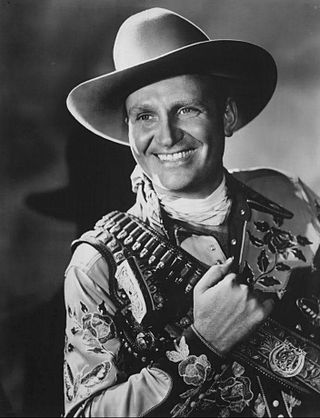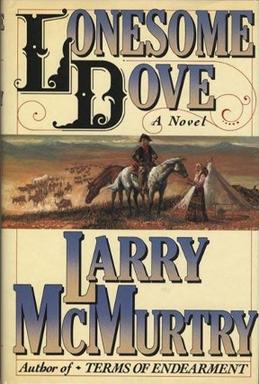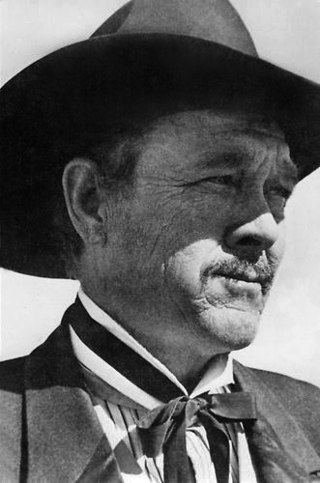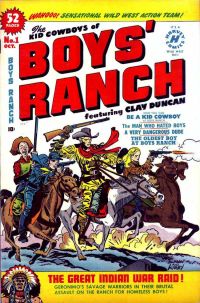
Waimea is a landlocked census-designated place (CDP) in Hawaii County, Hawaii, United States. The population was 7,028 at the 2000 census and 9,212 at the 2010 census. Since each U.S. state cannot have more than one post office of the same name, and there is a post office in Waimea, Kauai County, the official U.S. Post Office designation for Waimea is Kamuela, although this name is only used by the post office, not by locals or the local government. The name Waimea means reddish water.

A cowboy is an animal herder who tends cattle on ranches in North America, traditionally on horseback, and often performs a multitude of other ranch-related tasks. Cattle drives ensure the herds health in finding pasture and bring them to market. The historic American cowboy of the late 19th century arose from the vaquero traditions of northern Mexico and became a figure of special significance and legend. A subtype, called a wrangler, specifically tends the horses used to work cattle. In addition to ranch work, some cowboys work for or participate in rodeos. Cowgirls, first defined as such in the late 19th century, had a less well-documented historical role, but in the modern world work at identical tasks and have obtained considerable respect for their achievements. Cattle handlers in many other parts of the world, particularly in South America and stockmen and jackaroos in Australia, perform work similar to the cowboy.

Richard William Farnsworth was an American actor and stuntman. He was twice nominated for an Academy Award: in 1978 for Best Supporting Actor for Comes a Horseman, and in 2000 for Best Actor in The Straight Story, making him the oldest nominee for the award at the time. Farnsworth was also known for his performances in The Grey Fox (1982), for which he received a Golden Globe Award nomination for Best Actor in a Motion Picture - Drama, as well as Anne of Green Gables (1985); Sylvester (1985), and Misery (1990).

Orvon Grover "Gene" Autry, nicknamed the Singing Cowboy, was an American actor, musician, singer, composer, rodeo performer, and baseball team owner, who largely gained fame by singing in a crooning style on radio, in films, and on television for more than three decades, beginning in the early 1930s. During that time, he personified the straight-shooting hero — honest, brave, and true.

Lonesome Dove is a 1985 Western novel by American writer Larry McMurtry. It is the first published book of the Lonesome Dove series and the third installment in the series chronologically. It was a bestseller and won the 1986 Pulitzer Prize for Fiction. In 1989, it was adapted as a TV miniseries starring Tommy Lee Jones and Robert Duvall, which won both critical and popular acclaim. McMurtry went on to write a sequel, Streets of Laredo (1993), and two prequels, Dead Man's Walk (1995) and Comanche Moon (1997), all of which were also adapted as TV series.

Francis Benjamin Johnson Jr. was an American film and television actor, stuntman, and world-champion rodeo cowboy. Johnson brought authenticity to many roles in Westerns with his droll manner and expert horsemanship.

Thomas Edwin Mix was an American film actor and the star of many early Western films between 1909 and 1935. He appeared in 291 films, all but nine of which were silent films. He was Hollywood's first Western star and helped define the genre as it emerged in the early days of the cinema.

Rex Elvie Allen Sr., known as "the Arizona Cowboy", was an American film and television actor, singer and songwriter; he was also the narrator of many Disney nature and Western productions. For his contributions to the film industry, Allen received a motion pictures star on the Hollywood Walk of Fame in 1975, located at 6821 Hollywood Boulevard.

Southfork Ranch is a conference and event center in Parker, in the US state of Texas, 25 mi (40 km) north of Dallas. It includes the Ewing Mansion, the setting for the television series Dallas.

Francis Jameson Parker Jr. is an American actor, best known for his roles as the first Brad Vernon in the soap opera One Life to Live, and as A.J. Simon on the 1980s television series Simon & Simon.
Western lifestyle or cowboy culture is the lifestyle, or behaviorisms, of, and resulting from the influence of, the attitudes, ethics and history of the American western cowboy. In the present day these influences affect this sector of the population's choice of recreation, western wear, partaking of western cuisine and Southwestern cuisine, and enjoyment of the western genre and western music.

Sunset is a 1988 American crime mystery western film written and directed by Blake Edwards and starring Bruce Willis as Western actor Tom Mix, who teams up with lawman Wyatt Earp, portrayed for the second time in a theatrical film by James Garner. Based on an unpublished novel by Rod Amateau, the plot has Earp and Mix solve a murder in Hollywood in 1929.

Parker Ranch is a working cattle ranch on the Island of Hawaii in the U.S. state of Hawaii, now run by a charitable trust.

In Old Santa Fe is a 1934 American Western film directed by David Howard, starring Ken Maynard, George "Gabby" Hayes and Evalyn Knapp and featuring the first screen appearance of Gene Autry, singing a bluegrass rendition of "Wyoming Waltz" accompanied by his own acoustic guitar with Smiley Burnette on accordion. Autry and Burnette were uncredited, but the scene served as a screen test for the duo for subsequent singing cowboy films, beginning with The Phantom Empire (1935), in which Autry had his first leading role.

Boys' Ranch is a six-issue American comic book series created by the veteran writer-artist team of Joe Simon and Jack Kirby for Harvey Comics in 1950. A Western in the then-prevalent "kid gang" vein popularized by such film series as "Our Gang" and "The Dead End Kids", the series starred three adolescents—Dandy, Wabash, and Angel—who operate a ranch that was bequeathed to them, under the adult supervision of frontiersman Clay Duncan. Supporting characters included Palomino Sue, Wee Willie Weehawken, citizens of the town Four Massacres, and various Native Americans, including a fictional version of the real-life Geronimo.

Richard Palmer Kaleioku Smart (1913–1992) was an American musical theatre actor and singer who became owner of the largest private ranch in Hawaii.

Public Cowboy No. 1 is a 1937 American Western film directed by Joseph Kane and starring Gene Autry, Smiley Burnette, and Ann Rutherford. Based on a story by Bernard McConville, the film is about a singing cowboy who chases down rustlers who are using airplanes, shortwave radios, and refrigerated trucks to steal cattle.

The Big Sombrero is a 1949 American Western film directed by Frank McDonald and starring Gene Autry and Champion. Written by Olive Cooper, the film is about a singing cowboy hired as foreman of the Big Sombrero ranch by a man working against the interests of the ranch's absentee owner and workers. It was the last of two Autry Columbia films shot in Cinecolor, it was preceded by The Strawberry Roan.

Bose Ikard was an African-American cowboy who participated in the pioneering cattle drives on what became known as the Goodnight–Loving Trail, after the American Civil War and through 1869. Aspects of his life inspired the fictional character Joshua Deets, the African-American cowboy in Larry McMurtry's novel Lonesome Dove.

Smoky is a 1966 American Western film, directed by George Sherman and starring Fess Parker, Diana Hyland, Katy Jurado and Hoyt Axton. The third of three film adaptations of the 1926 novel Smoky the Cowhorse by Will James, it utilizes the screenplay from the 1946 film.


















